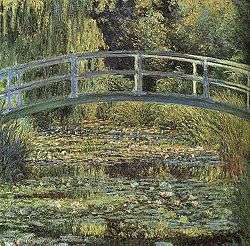Epte
| Epte | |
|---|---|
 Monet's "Waterlily Pond", painted 1899, was created by diverting a branch of the Epte. | |
| Country | France |
| Basin | |
| Main source |
Normandy 190 m (620 ft) |
| River mouth |
Seine 49°3′40″N 1°31′42″E / 49.06111°N 1.52833°ECoordinates: 49°3′40″N 1°31′42″E / 49.06111°N 1.52833°E |
| Progression | Seine→ English Channel |
| Basin size | 1,403 km2 (542 sq mi) |
| Physical characteristics | |
| Length | 112.5 km (69.9 mi) |
| Discharge |
|
The Epte is a river in Seine-Maritime and Eure, in Normandy, France. It is a right tributary of the Seine, 112.5 km (69.9 mi) long.[1] The river rises in Seine-Maritime in the Pays de Bray, near Forges-les-Eaux. The river empties into the Seine not far from Giverny. One of its tributaries is the Aubette de Magny.
In 911 the Treaty of Saint-Clair-sur-Epte established the river as the historical boundary of Normandy and Île-de-France.
Claude Monet lived at Giverny near the river for more than forty years. In his garden, by diverting a branch of the Epte, he established a water garden with its famous water-lily pond and its Japanese-style bridge. The river appears in a number of his works, including Peupliers au bord de l'Epte.
References
| Wikimedia Commons has media related to Epte. |
This article is issued from Wikipedia - version of the 5/20/2016. The text is available under the Creative Commons Attribution/Share Alike but additional terms may apply for the media files.